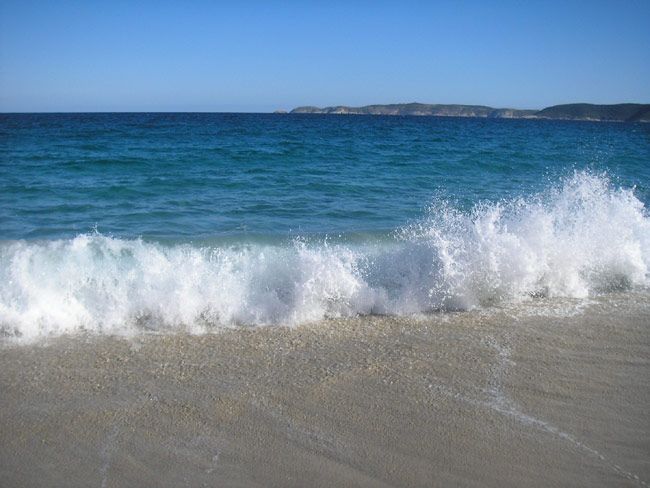Rising Seas to Destroy U.S. Beaches

You may have to kiss that summer trip to the beach goodbye later this century, thanks to rising sea levels and more intense tropical storms, scientists predict.
A new study of the potential sand losses to North Carolina beaches reports that a 1-foot rise in sea level in the next 25 to 75 years (which is at the lower end of the range predicted by the Intergovernmental Panel on Climate Change) would cause the coast to move inland by 2,000 to 10,000 feet and could cost an estimated $223 million in lost recreational value by 2080 to beach-goers in that state alone.
Predicting exactly how much beaches will shrink is impossible because beach erosion rates are highly variable, even between points that are only a few miles apart. The make-up of each beach's sand, the absence or presence of jetties and other man-made structures meant to retain sand, and offshore topography (which influences wave formation), all affect erosion rates.
But even with all the uncertainty, scientists say the future of our beloved sandy havens doesn’t look good.
“We have no way of predicting what sea level rise will do to erosion rates, except to say that they will increase,” said Duke University geologist Orrin Pilkey, who was not involved in the new study.
Forces of erosion
Hurricanes pose a particular threat to beaches because the floods of ocean water they can push onshore, called storm surge, can wash away large amounts of sand. Typically the sand returns to the beaches (so there’s plenty available to build that sandcastle or bury your dad). But if global warming intensifies hurricanes as some have predicted (either by increasing their frequency or the strength of individual storms), it may also impair beaches’ ability to recover.
Sign up for the Live Science daily newsletter now
Get the world’s most fascinating discoveries delivered straight to your inbox.
For North Carolina’s beaches, the report says, even if hurricanes strike with their current frequency and intensity, sea level rise will make the effects of the storms worse.
Sea level rise is another ominous potential eroding force, at least for beaches that are highly developed. When seas rise, undeveloped beaches can simply shift further inland, but because roads, buildings and other man-made structures act as a barrier, the sand at developed beaches cannot migrate backward. Effectively, relentless waves will wear away the sand and these beaches will shrink until there’s simply no sand left for sunbathing or seaside strolls.
“We create the [beach erosion] problem,” Pilkey said.
In fact, Pilkey says, the building of jetties and sea walls may be doing the most damage for now, because while they preserve a small portion of the shoreline near the structure, they actually result in more coastal erosion further from the structure than would have occurred naturally.
“I suspect that may be more important than sea level rise,” he told LiveScience, but that trend will eventually change later, with global warming’s forces surpassing the impact of sea walls and jetties.
For West Coast U.S. beaches, erosion from sea level rise and storms is less of a threat than on the East Coast, because the "left" coastline tends to be higher and steeper, but that doesn’t mean beach-goers there are in the clear. One of the main sources of sand for these beaches is river transport, but dams built along western rivers block this sand, which causes the beaches to erode.
More crowded beaches
With beaches slowly vanishing from the coasts, vacationers might have to find some other way to entertain themselves and soak up the sun in the summer in the coming decades.
“I’m predicting that they [will take] fewer beach trips,” said lead author of the North Carolina study John Whitehead of Appalachian State University in North Carolina. The report was funded by the National Commission on Energy Policy, a bipartisan, non-profit group of energy experts.
By surveying beach-goers, Whitehead found that people prefer wider beaches, which provide more room for throwing Frisbees and eating sandy sandwiches. By determining how far people will drive to these roomier beaches and calculating the cost of those drives, Whitehead estimated the millions of dollars that would be lost to vacationers.
And for those for whom the allure of a vacation at the beach is simply irresistible, few options will be left, as the only beaches to survive would likely be the ones that are undeveloped now.
“People would have more limited beach options,” sociologist Maureen Harrington of Griffith University in Australia said in an email interview. “[They] would have to go to beaches that are able to migrate, that are not urbanized … so these beaches would be more crowded.”
- Video: Goldilocks and the Greenhouse
- Top 10 Surprising Results of Global Warming
- Timeline: The Frightening Future of Earth

Andrea Thompson is an associate editor at Scientific American, where she covers sustainability, energy and the environment. Prior to that, she was a senior writer covering climate science at Climate Central and a reporter and editor at Live Science, where she primarily covered Earth science and the environment. She holds a graduate degree in science health and environmental reporting from New York University, as well as a bachelor of science and and masters of science in atmospheric chemistry from the Georgia Institute of Technology.
Most Popular


